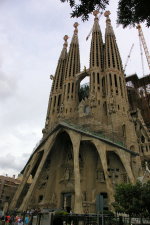

|
News, October 2010AVE tunnel passes Sagrada Familia Cathedral15th October. Reports from Barcelona say that the machines tunnelling below the city have passed within metres of the famous Sagrada Familia Cathedral, due to be consecrated by Pope Benedict in November. It is coincidental that this news comes the same day that the Gotthard Base tunnel broke through below the Alps in Switzerland, but both events speak for substantial and rapid economic and social change in Europe, overseen by a rather sedentary Christian scene.High Speed Rail, known in Spain as the AVE (or bird, but acronym for High Speed Spain) has indeed sped its extension across Spain in the past decade. The first AVE line, however, was not primarily along a key economic route. It went from Madrid to Seville and opened in time for the 1992 World fair. It was also, incidentally, the route to the home of the then president Felipe González. The line to Spain's second city and economic power house, Barcelona, was only completed 14 years later, in 2006. Since then however, lines have spread across much of Spain and the latest line will link Madrid with Valencia, much of the growth financed by EU subsidies. On 12th December this year, the first international line will open across the Pyrenees, but only between the cities of Figureas and Perpignan. French TGV services will thus link Figueras with any part of France via Perpignan and - for the foreseeable future on conventional rail to Montpellier. The line from Barcelona to Figueras, 125km (80 miles) will be completed by 2014, if cuts do not delay it... or problems in the tunnels under Barcelona and Girona. The main concern has been in Barcelona, where the tunnel runs just metres away from the foundations of the Sagrada Familia cathedral. This building was started almost a century ago, designed by the architect Antonio Gaudí, and remains incomplete. Nevertheless, on 7th November it is to be consecrated by Pope Benedict. The drawings had been lost, but some years ago were rediscovered and work proceeded under public subscription. Compared to the building of the AVE tunnel, or even the 20 year Gotthard project under the Alps, the building of this cathedral shows that the church in Spain is moving at a snail's pace. Indeed, the Catholic Church is losing members fast and every survey shows a smaller number of people considering themselves Catholic, baptising their children, marrying, etc.. Nevertheless, just as the AVE has spread across Spain over the past decade, so also the evangelical churches have grown fast on the back of Spain's incredible immigration rush. When Franco died in 1975, there were at most 70,000 evangelical church members. In 1996 it was estimated that membership had risen to almost 90,000. Apart from the odd Anglo-Saxon missionary, the vast majority of members were indigenous Spaniards. In the subsequent decade at the most conservative estimates membership doubled. Now most estimates consider that, whether church members or not, there must be at least half a million who would consider themselves evangelical or protestant in Spain. Surprisingly, it has been Spain's economic miracle which caused such amazing church growth. Migrant workers poured in from countries where the gospel has been widely preached. In particular the believers come from Latin America, West Africa and Eastern Europe. Now the question is whether the churches can retain such a large number of members, with many churches having half or more of the members unemployed. Likewise, in the Spanish economy questions a rife concerning the ability to keep building. EU subsidies have come to an end and Spain is now a net contributor to the budget. Its austerity budget for 2011 sets cuts across the board, especially for infrastructure projects. Some are cut completely, others will suffer delays. Environmentalist groups are also concerned by threats to wildlife in the country and heritage sites in the cities. Perhaps the churches also need to concentrate once again on establishing strong indigenous foundations! |
